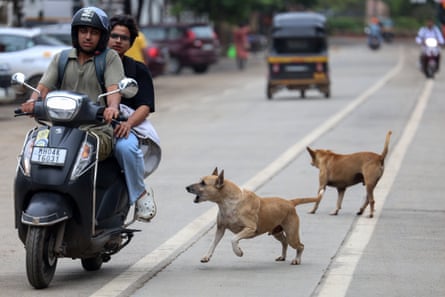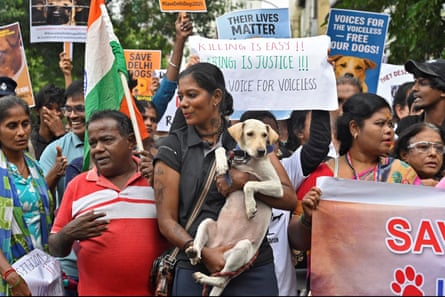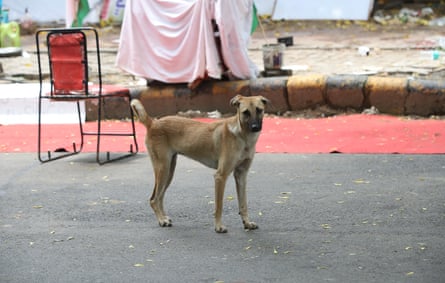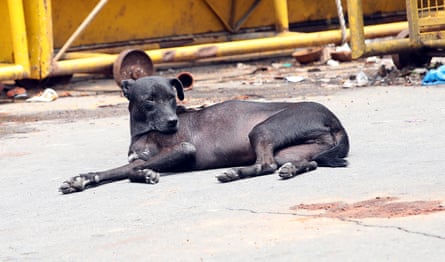PROTECT YOUR DNA WITH QUANTUM TECHNOLOGY
Orgo-Life the new way to the future Advertising by AdpathwayIndia’s top court has scaled back an order to clear Delhi’s streets of stray dogs, in a decision that was cheered by animal rights supporters.
Earlier this month, the supreme court ruled that all strays picked up in Delhi’s capital region would be confined to shelters after sterilisation and vaccination, and not returned to the streets. The goal was to protect people – particularly children – from dog attacks and rabies, which remains endemic in India.
Critics had said the plan was unrealistic. Veterinarian Harjun Singh said: “The cost of constructing proper shelters would be prohibitive. Rounding them up and putting them in cages would have been another way of condemning them to death.” Delhi, a city of 35 million people, is estimated to be home to as many as 1 million stray dogs.

In a new ruling on Friday the same court suspended the “catch-and-keep” plan, recommending a more “holistic” India-wide approach. Dogs, the court said, should be sterilised, vaccinated, dewormed and returned to their neighbourhoods, with only those showing aggression or suffering from rabies kept in shelters.
Animal welfare group Peta said: “They say every dog has her day, and today is the day [for India’s] community dogs. The decision shows the majority think of community dogs as beloved neighbours and friends. Now, with a renewed focus on sterilisation and vaccination, the rest of India can move closer to the day that no dogs are left to suffer hunger, accidents and cruelty on the roads.”
Delhi’s streets are alive with mixed-breed “indies” – hardy and intelligent dogs prized for their resilience. Their numbers, however, have long sparked tension between public safety authorities and animal welfare advocates.

Tensions turned violent earlier this week when Delhi’s chief minister, Rekha Gupta, who has made removing strays from the streets a top priority, was assaulted by a man described by his family as a passionate dog lover with mental-health issues. The man allegedly pushed, slapped and pulled her hair. He has been charged with attempted murder.
The court also directed municipal authorities to set up feeding spaces for strays, aiming to feed them safely, monitor their health, and reduce conflicts with people. Critics say, however, that such spaces are hard to manage, can trigger dog fights, and many municipalities lack the infrastructure to run them effectively.
On any given day, Delhi’s street dogs lounge on pavements, roam alleys and wait patiently at tea stalls for biscuits and milk. In markets, shopkeepers toss scraps of leftover rotis. Outside temples, they wander among worshippers. In Hindu tradition, they are linked to Bhairava, a fierce, protective aspect of Shiva, one of the religion’s principal deities. Feeding them is considered an act of kindness, believed by some to bring protection and good fortune.

Many strays answer to names given by residents like Kalu (black), Brownie and Chhotu (small). Some wear collars, marking them as part of the community even if people can’t house them. “Street dogs have created bonds with the people,” said city chronicler Mayank Austen Soofi. “They form very active relationships with grocers and shopkeepers, with families, and with the homeless who treat them like companions. These dogs are friendly and have woven themselves into human lives.”
Still, though, India accounts for roughly one-third of the world’s rabies deaths, up to 20,000 a year, according to the World Health Organization, making stray dog management a critical public health concern. “People have the right to go for walks without being frightened of being bitten and chased by dogs,” said one city-centre resident. Delhi, however, reported zero rabies deaths between January 2022 and January 2025. Bite cases fluctuate: 17,874 in 2023, dropping to 6,691 in 2024.
Despite the risks many residents welcome the dogs’ presence. Delhi resident Ashima Sharma said: “They belong here. That’s why we don’t use the word strays or street dogs: we call them community dogs. They’re also useful because they bark at strangers entering late at night.”

Even in Khan Market, a hub for Delhi’s more affluent population, shopkeepers feed them and proudly point out longtime “residents”. In winter, NGOs often provide brightly coloured jackets to keep them warm.
The court’s earlier order had shocked animal welfare groups, breaking with years of precedent. Since 2009, the supreme court has affirmed that sterilised and vaccinated dogs must be returned to their localities. In 2014, it said that “stray dogs have the right to live” and that compassion toward all living things was a “constitutional value” in animal welfare law.
Rahul Gandhi, the opposition Congress leader, called the revised court order a “progressive step toward balancing animal welfare and public safety”.
Soofi said: “The sounds of Delhi are full of dogs barking. Their barks and howls are part of the night music of the city. They are integral to the texture of Delhi, to its very soul. If Delhi lost its street dogs, something essential would disappear.”


 6 hours ago
4
6 hours ago
4





















 English (US) ·
English (US) ·  French (CA) ·
French (CA) ·